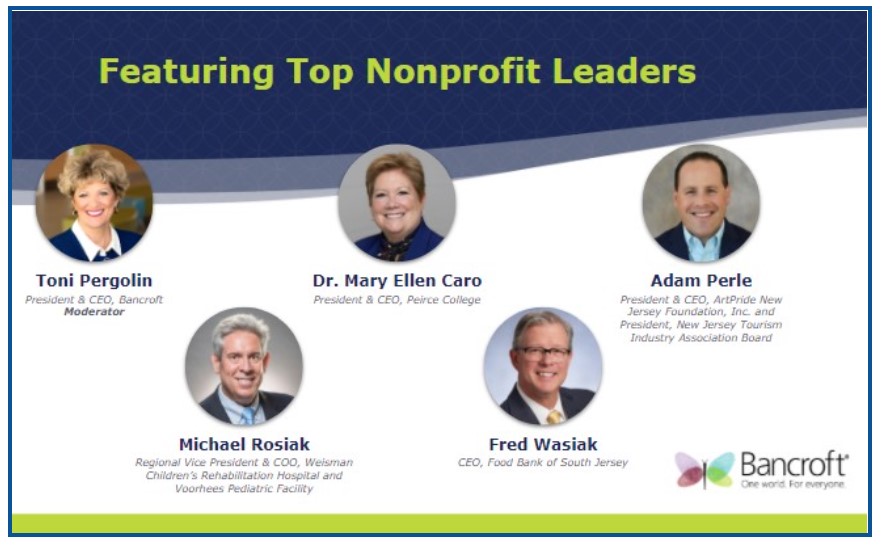I hosted a CEO Roundtable recently with executives from different sectors who related the pandemic-related experiences and challenges they faced, and how, while still in COVID crisis mode, they are focused on the future and on creating their next normal. The Roundtable featured Dr. Mary Ellen Caro, Peirce College, Adam Perle, ARTPride NJ Foundation and NJ Tourism Industry Association Board, Michael Rosiak, Weisman Children’s Rehabilitation Hospital and Voorhees Pediatric Facility, and Fred Wasiak, Food Bank of South Jersey.
Standing up to COVID and the havoc it would wreak on each of the organizations we lead was top of mind. We went into “overdrive” to deal with the complexity of it all as we were trying to look for more curves in the road ahead. While the Food Bank of South Jersey was called on to ramp up its services, member organizations of ARTPride went dark. Bancroft and Weisman Children’s went hunting for PPE while communicating nearly daily guidance to their front line staff, and Peirce College was transitioning to online learning with a suddenly transformed student body. As we were leading our organizations through the unknown, everyone was looking to us for answers.
The safety of our employees and clients required our immediate attention, particularly for the Bancroft and Weisman Children’s organizations caring for vulnerable children and adults. Communicating with our essential staff, providing our teams with PPE and training them on how to use it properly and environmental cleaning were primary for our staff who were caring for individuals facing the suspension of family visits and community activities.
We all agreed that we could not over communicate. We needed to inform, engage and align ourselves with all levels of staff so they understood what was going on and had confidence in our response to the pandemic. We needed to be present and accessible, and most of all, expressive of our appreciation for the work they do whether it’s on the front lines or behind the scenes.
The mental and emotional wellbeing of our collective employees has been critical. Whether they were experiencing stress on the job or wondering about the future of their employment all while dealing with family stressors, we all felt a responsibility to extend and expand care.
Even as the specifics of dealing with the pandemic and preventing its spread were front and center, as leaders we had a responsibility to refocus on the horizon. Coincidentally, each organization had completed the development of a strategic plan early in 2020. Knowing it couldn’t just be taken off the shelf in the light of the new day, we discussed how to assess it in the light of the new day.
What did we find? Our strategies were generally solid, but many of the initiatives had changed. Some, like a move toward delivery of rehabilitation therapy by telehealth, had been fast tracked due to the pandemic. Plans to expand markets and audiences took new exciting shapes. We also recognized that many nonprofit organizations and businesses were not going to survive the financial losses brought on by the crisis and that opportunities to acquire and partner were possible – for organizations that were strong going into the crisis.
Which leads me to my “no margin, no mission” mantra. The ultimate responsibility of the leader of a nonprofit organization is to budget and deliver a margin – every year. If you don’t, coming out of a crisis unhurt is improbable and emerging strong and prepared to grow is unlikely. In either case, mission based organizations will only be positioned to deliver on their missions when they embrace financial discipline and adhere to best business practices.
As we continue to manage through the crisis, we are making changes for the short term and planning for the long term. We continue to face challenges – most notably the lack of an end date – but we see opportunities emerging around us ready for those who can step up.
Click here to listen to the webinar.

